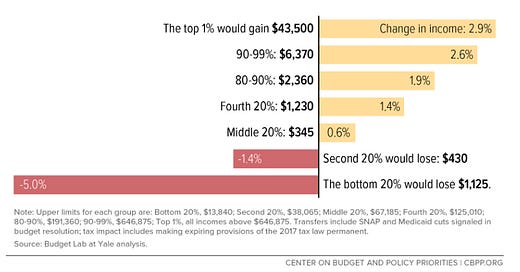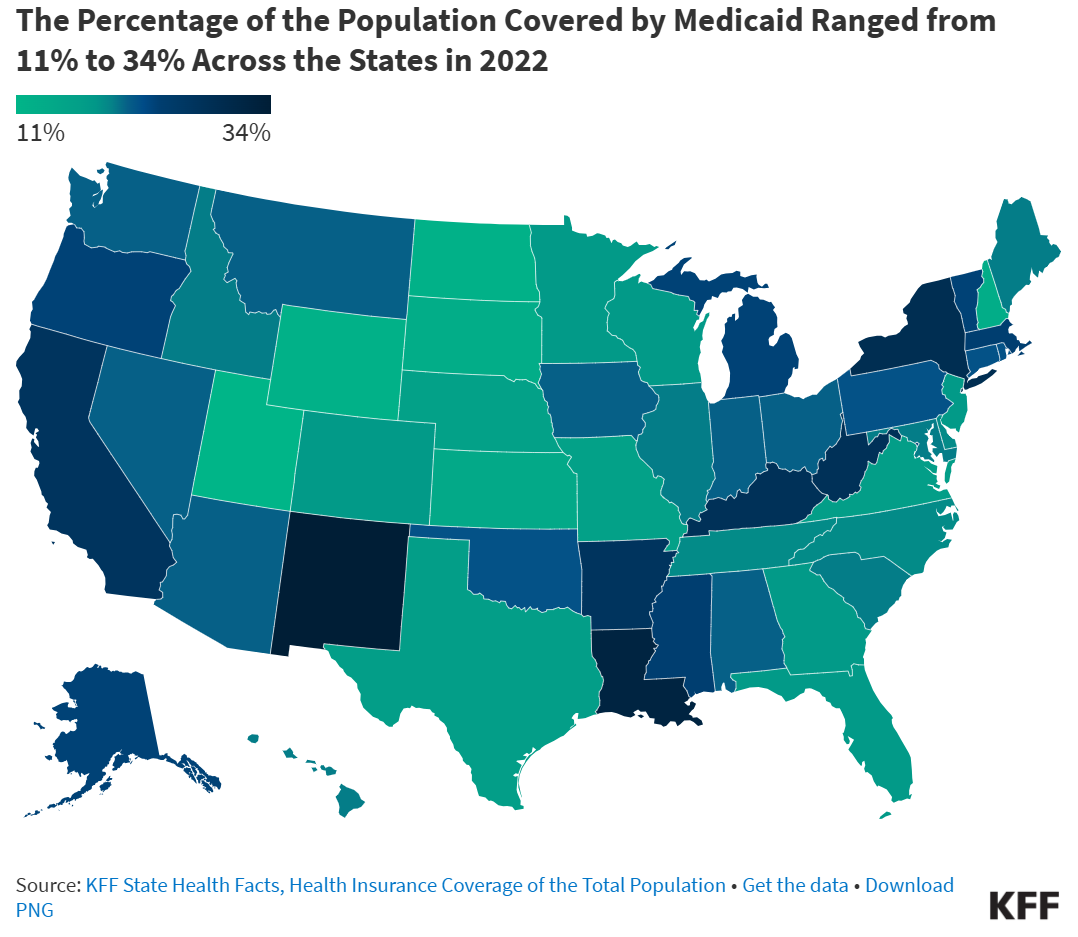*Thanks to everyone who filled out the survey last week! I’m working through the questions for you. And, you all love nachos and dogs! I have found my crew here!
Also, the paid annual subscription is 40% off during Lent if that interests you. For the paid subscribers, I do more personal posts on the weekends. The science is always free! But for those of you who want more personal reflections on life, how I’m dealing with the world, and hopefully encouragement, we’d love to see you!*
Why talk about Medicaid?
The US House recently passed a resolution for the largest Medicaid cut in history. The number is at least $880 billion over the next ten years to finance extra tax breaks (mainly for wealthy individuals and corporations), military spending increases, and deportations. (I talk more about the tax breaks below.) Many of us don’t really know what Medicaid does and how incredibly beneficial it is to our neighbors who need it the most. Let me show you why.
What is Medicaid?
Medicaid provides healthcare to 80 million people in the US (1 in 5 people living in the US) - 48% are children. Medicaid enrollees increased in all states during the pandemic except eight. In my state of NC, Medicaid enrollment increased by 57% during/after the pandemic.
Importantly, the Affordable Care Act’s (ACA) expanded Medicaid coverage to 20 million adults with low incomes. Keep this in mind as we keep going in this post!
Who is covered by Medicaid?
Medicaid accounts for 19% of healthcare spending. At the federal level, Medicaid is administered by the Department of Health and Human Services (HHS). As noted above, 1 in 5 people in the US are covered by Medicaid. But, that’s the average and is much higher for some populations.
For children in poverty, it’s 8 in 10 children. For adults in poverty, it is 6 in 10.
60% of all Black children are covered under Medicaid.
For Black, Hispanic, and American Indian or Alaska Native children and adults, the rate of coverage is 1.5-3 times higher than White children and adults.
Medicaid also covers 44% of services for adults with disabilities, 40% of services for adults with HIV, and nearly 50% of services for children with special needs.
Medicaid also provides critical coverage for persons experiencing homelessness or re-entering the workforce after incarceration.
What is covered by Medicaid?
Medicaid offers a massive amount of comprehensive services, especially those services needed in certain populations that aren’t covered under traditional insurance. For example, Medicaid provides disability services for children that goes beyond primary care services. And those disability services are pricey without Medicaid! For adults, it provides rural health clinic services, midwifery and birth center services, transportation to medical appointments, nursing facilities, home health services, and many others. For over 1,300 US community health centers, which serve as the main safety net clinics for low-income individuals, Medicaid provides coverage for maternity and postpartum services, vision, emergency care, hospital services, and primary care. For rural hospitals, who are already at risk of closing, Medicaid helps keeps the doors open and improves financial performance.
What about the chatter about work requirements?
Most of the talking points around cutting Medicaid you might hear on the news is that the enrollees don’t have a job and rely on Medicaid as a free hand-out. That is further from the truth. Not only does Medicaid helps adults become financially secure and healthier (see below), it also makes no sense to have a work requirement. 90% of adults covered with Medicaid are already working (64%) or are taking care of a family member (12%), go to school (6%), or are disabled (10%). Only 2% could not find work.
Why would a cut matter?
Like a good neighbor, Medicaid cuts would not be equal. For people supported through Medicaid, 19% of their healthcare spending is through the program. Notice in the graph below that out-of-pocket payment for medical care is still 13% for these enrollees. So a Medicaid cut for those families would increase their out of pocket medical expenses by an additional 19%. To put this in perspective, think of your monthly take home pay and that you’re living nearly paycheck to paycheck. If you lose Medicaid, you have to find an additional 20% to cover those costs. It is a huge amount for families already in financial hardship. Medicaid, though, can lessen that burden for them.
Think also through your last visit to the doctor and what did you pay for a co-pay or services? If you have insurance, a good chunk of that bill is covered with insurance. For 40 million adults and 40 million children in the US, Medicaid covers alot of their healthcare costs. For low-income families, the ACA expansion of Medicaid improved access to care to medical care like mammograms, primary care visits for diabetes, and cancer treatments. Additionally, their health outcomes improved too with at least 19,000 lives saved.
For me, this is one of the most important impacts if Medicaid is cut.
Many of you know that my day job as a global health epidemiologist is researching the intersection of poverty and children’s health in low-income settings. The link is inextricable. Families have to make unbearably hard decisions between healthcare for one family member and food for the rest of the family. That is here in the US and internationally.
For low-income families in the US, Medicaid covers medical bills that would otherwise come out of their pockets - which is why access and timeliness to care is improved for these families. In other words, they don’t have to ask the decision of seeking healthcare for one child or feeding the others. Medicaid helps make that decision obsolete so they can their mammograms or primary care visits on time. And feed their families. Under Medicaid, the decision between healthcare and food is easier to make since Medicaid covers some of the bills. However, President Trump’s recent budget reduction plan calls for massive cuts in both Medicaid and in SNAP, the Supplemental Nutrition Assistance Program, which provides food assistance to millions. The reduction in both Medicaid and SNAP would be catastrophic to families already struggling financially. Let me show you.
Families in the lowest 20% of income (below $14,000 a year) would lose more than $1,000 per year due to these cuts. On the other hand, high-income households would benefit with huge tax cuts. People in the top 1% would gain $43,500. In other words, families in the bottom 40% would “bear the brunt of the spendings cuts.” In other words, if we look at this issue through the lens of neighboring, this is an equity issue.
Investing in healthcare is more cost-saving than cutting services.
If you’ve read my book, you might remember my chapter about trickle-up economics rather than trickle-down economics. This is especially true here. My research shows time and time again that investing in healthcare for the poorest in societies impacts the entire country more than beginning with the wealthy. Imagine giving Zuckerberg or Bezos $1,000 and having it trickle-down to a low-income family. This wouldn’t happen and it’s also fiscally irresponsible. From a health economic standpoint, starting with the poor is where you get your biggest bang for your buck. My research has found that investing in children’s health in conflict zones and some of the poorest countries in the world has a return of investment of 14 to 1. For every dollar you invest, the community and health systems benefits by a margin of $14. Preferential option for the poor is a strategic investment for economies wealth and health. When it comes to Medicaid, the ACA expansion produced savings for a majority of the states, improved the individual enrollees financial situations, and had positive economic impacts on hosiptals. Trickle up economics benefits us all!
Bringing it all together through the lens of equitable neighboring.
The impact of cutting Medicaid is not equal and detrimentally impacts those already affected by poverty and inflation. This to me is an equity issue. Neighboring one another through this means we can call our Senators and Congress people, we can donate to food pantries in our city, and do it again tomorrow. Money is so tight for most people right now with the economy. This is especially true for our neighbors who rely on Medicaid to help put food on the table for their kids.
In solidarity,
Emily







Your defense as to why it is 'bad economics' to not support those less fortunate is sound & I am confident your statistical analysis is equally robust.
There is logic to improving efficiency with respect to delivering services, particularly in healthcare expenses.
The DOGE thing is simply a smokescreen & diversion by Trump to appear as he is making the system... government...a better conservative of the healthcare expenses.
Trump is not smart, no bully is smart & eventually every bully is exposed to who they are...insecure & incapable of being a leader.
The consequences of Trump's actions & enabling others to stop funding truly life saving programs internationally has caused deaths... reported in the NY Times & other reputable news sources...these tragic consequences will unfold in the US.
I am fortunate in many ways & it's equally true for the healthcare services available in Canada. Our system is also in need of improvement yet it is more equatable, particularly for those less fortunate.
I like so many of those in America 🙏for the bully residing at 1600 Pennsylvania Ave being exposed for who he is & the compationate citizenry work to repair the damage he is causing. JJF Phm 🇨🇦
I think many the care for many nursing home patients is paid for by MEDICAID. What are the numbers? Am I correct? What would happen to these patients if their Medicaid benefits were reduced or eliminated?